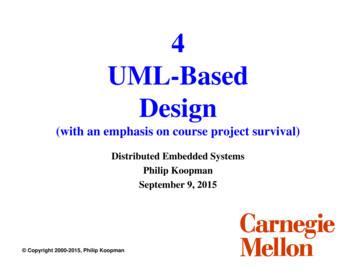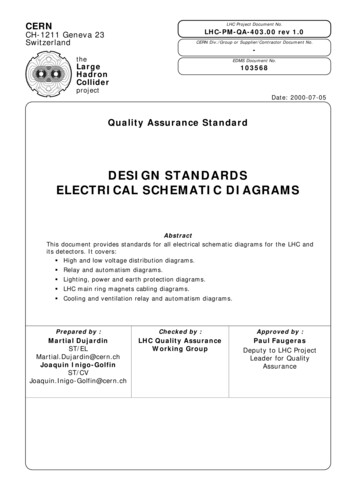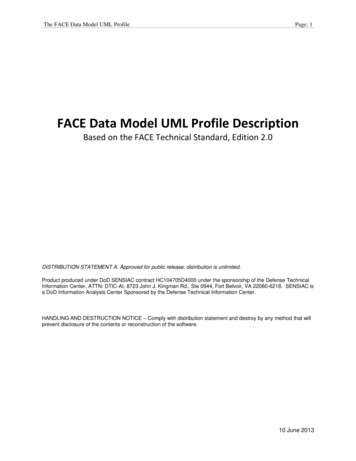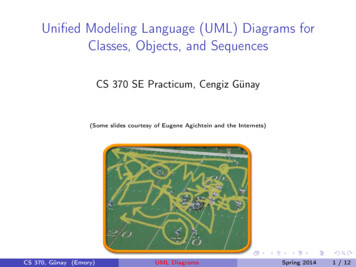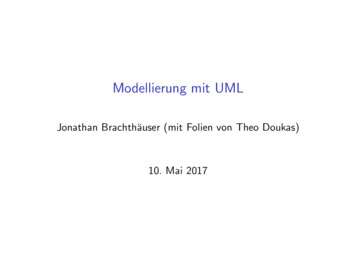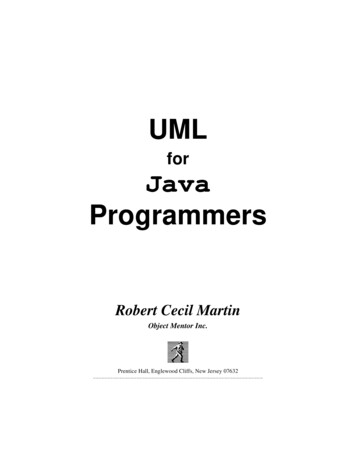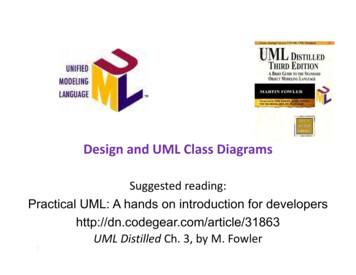
Transcription
Design and UML Class DiagramsSuggested reading:Practical UML: A hands on introduction for developershttp://dn.codegear.com/article/31863UML Distilled Ch. 3, by M. Fowler1
How do peopledraw / write downsoftware architectures?
Example architecturespersonsea agentVerizonWirelessUW studentlake agentGPS satelliteCSE 403studentamphibiousagentCell phone
Big questions What is UML?– Why should I bother? Do people really use UML? What is a UML class diagram?– What kind of information goes into it?– How do I create it?– When should I create it?
Design phase design: specifying the structure of how a softwaresystem will be written and function, without actuallywriting the complete implementation a transition from "what" the system must do, to"how" the system will do it– What classes will we need to implement a system thatmeets our requirements?– What fields and methods will each class have?– How will the classes interact with each other?
How do we design classes? class identification from project spec / requirements– nouns are potential classes, objects, fields– verbs are potential methods or responsibilities of a class CRC card exercises– write down classes' names on index cards– next to each class, list the following: responsibilities: problems to be solved; short verb phrases collaborators: other classes that are sent messages by this class(asymmetric) UML diagrams– class diagrams (today)– sequence diagrams– .
What is UML? UML: pictures of an OO system– programming languages are not abstract enough for OOdesign– UML is an open standard; lots of companies use it What is legal UML?– a descriptive language: rigid formal syntax (likeprogramming)– a prescriptive language: shaped by usage and convention– it's okay to omit things from UML diagrams if they aren'tneeded by team/supervisor/instructor
Uses for UML as a sketch: to communicate aspects of system––––forward design: doing UML before codingbackward design: doing UML after coding as documentationoften done on whiteboard or paperused to get rough selective ideas as a blueprint: a complete design to be implemented– sometimes done with CASE (Computer-Aided SoftwareEngineering) tools as a programming language: with the right tools, code canbe auto-generated and executed from UML– only good if this is faster than coding in a "real" language
UMLIn an effort to promote Object Oriented designs,three leading object oriented programmingresearchers joined ranks to combine theirlanguages:– Grady Booch (BOOCH)– Jim Rumbaugh (OML: object modeling technique)– Ivar Jacobsen (OOSE: object oriented software eng)and come up with an industry standard [mid 1990’s].
UML – Unified Modeling Language Union of all Modeling Languages––––––––––Use case diagramsClass diagramsObject diagramsSequence diagramsCollaboration diagramsStatechart diagramsActivity diagramsComponent diagramsDeployment diagrams;. Very big, but a nice standard that has beenembraced by the industry.
Object diagram ( class diagram) individual objects (heap layout)– objectName : type– attribute value lines show fieldreferences Class diagram:– summary of all possible object diagrams
Object diagram example
UML class diagrams UML class diagram: a picture of– the classes in an OO system– their fields and methods– connections between the classes that interact or inherit from each other Not represented in a UML class diagram:– details of how the classes interact with each other– algorithmic details; how a particular behavior isimplemented
Diagram of one class class name in top of box– write interface on top of interfaces' names– use italics for an abstract class name attributes (optional)– includes fields of the object operations / methods (optional)– may omit trivial (get/set) methods but don't omit any methods from an interface!– should not include inherited methods
Class attributes ( fields) attributes (fields, instance variables)– visibility name : type [count] default value– visibility: public#protectedprivate package (default)/derived– underline static attributes– derived attribute: not stored, but canbe computed from other attribute values “specification fields “ from CSE 331– attribute example:- balance : double 0.00
Class operations / methods operations / methods– visibility name (parameters) : return type– visibility: public#protectedprivate package (default)– underline static methods– parameter types listed as (name: type)– omit return type on constructors andwhen return type is void– method example: distance(p1: Point, p2: Point): double
Comments represented as a folded note, attached to theappropriate class/method/etc by a dashed line
Relationships between classes generalization: an inheritance relationship– inheritance between classes– interface implementation association: a usage relationship– dependency– aggregation– composition
Generalization (inheritance) relationships hierarchies drawn top-down arrows point upward to parent line/arrow styles indicate whether parent isa(n):– class:solid line, black arrow– abstract class:solid line, white arrow– interface:dashed line, white arrow often omit trivial / obvious generalizationrelationships, such as drawing the Object classas a parent
Associational relationships associational (usage) relationships1. multiplicity *12.43.*(how many are used) 0, 1, or more 1 exactly between 2 and 4, inclusive 3 or more (also written as “3.”)2. name3. navigability(what relationship the objects have)(direction)
Multiplicity of associations one-to-one each student must carry exactly one ID cardone-to-many one rectangle list can contain many rectangles
CarAssociation types aggregation: “is part of”– symbolized by a clear white diamond11Engine composition: “is entirely made of”– stronger version of aggregation– the parts live and die with the whole– symbolized by a black diamondaggregationBookcomposition1*Page dependency: “uses temporarily”– symbolized by dotted line– often is an implementationdetail, not an intrinsic part ofthat object's statedependencyLotteryTicketRandom
Composition/aggregation exampleIf the movie theater goes awayso does the box office compositionbut movies may still exist aggregation
Class diagram exampleNo arrows; info flows inboth directions; eachknows about the otherAggregation – Order classcontains OrderDetailclasses. Could becomposition?
UML example: peopleLet’s add the visibility attributes
Class diagram: voters26
Class diagram example: video ntal InvoiceAbstractClassRental ionCheckout ScreenDVD MovieVHS MovieVideo Game
Class diagram example: studentStudentBody main (args : String[])Address- streetAddress : String- city : String- state : String- zipCode : long toString() : String1100Student- firstName : String- lastName : String- homeAddress : Address- schoolAddress : Address toString()toString() : String
Tools for creating UML diagrams Violet (free)– http://horstmann.com/violet/ Rational Rose– http://www.rational.com/ Visual Paradigm UML Suite (trial)– http://www.visual-paradigm.com/– (nearly) direct download p?product vpuml&edition ce(there are many others, but most are commercial)
Design exercise: Texas Hold ‘em poker game 2 to 8 human or computer playersEach player has a name and stack of chipsComputer players have a difficulty setting: easy, medium, hardSummary of each hand:– Dealer collects ante from appropriate players, shuffles the deck, anddeals each player a hand of 2 cards from the deck.– A betting round occurs, followed by dealing 3 shared cards from thedeck.– As shared cards are dealt, more betting rounds occur, where eachplayer can fold, check, or raise.– At the end of a round, if more than one player is remaining, players'hands are compared, and the best hand wins the pot of all chips bet sofar. What classes are in this system? What are their responsibilities?Which classes collaborate? Draw a class diagram for this system. Include relationships betweenclasses (generalization and associational).
Class diagram pros/cons Class diagrams are great for:––––discovering related data and attributesgetting a quick picture of the important entities in a systemseeing whether you have too few/many classesseeing whether the relationships between objects are toocomplex, too many in number, simple enough, etc.– spotting dependencies between one class/object and another Not so great for:– discovering algorithmic (not data-driven) behavior– finding the flow of steps for objects to solve a given problem– understanding the app's overall control flow (event-driven?web-based? sequential? etc.)
Uses for UML as a sketch: to communicate aspects of system – forward design: doing UML before coding – backward design: doing UML after coding as documentation – often done on whiteboard or paper – used to get rough selective ideas as a blueprint: a complete design to be implemented – sometimes done with CASE (Computer-Aided .
